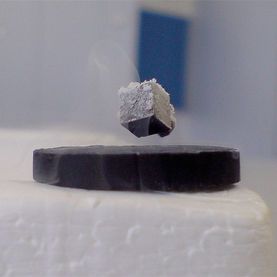Warm Currents: Graphite Powder Stirs Up Hints of Room-Temperature Superconductivity
Sophie Bushwick
Scientific American

Is a magnetic signal in water-treated graphite powder a sign of room-temperature superconductivity or a false alarm?
A recent discovery in a study of room-temperature superconductivity, if borne out, could make the dream of super-efficient long-distance electricity transmission and levitating trains a little closer to reality.
Whereas physicists understand how standard superconductors can operate at nearly 275 degrees Celsius below water's freezing point, the mechanism behind high-temperature superconductors, which function at up to 140 degrees warmer than absolute zero, remains mysterious. Without knowing exactly how these warmer substances would manage to conduct electricity with zero resistance, researchers still don't know whether it's possible for anything to be superconductive at comparatively hot room-temperature conditions—which is what a new study claims.
According to a paper in Advanced Materials, cheap and easily obtainable graphite powder exhibits signs of superconductivity. And it doesn't need to be chilled with an expensive cryostat system—all it takes to make the powder superconductive is a simple water bath.
Pablo Esquinazi and other physicists from the University of Leipzig first discussed graphite as a potential superconductor in a 2012 paper published on arXiv, an electronic archive of preprint scientific papers. (The researchers have also made their new paper available there.) Certain parts of the material showed signs of the Josephson effect, when electrons tunnel between a barrier separating two superconductors. The effect indicated that the graphite samples contained superconducting areas.
"Due to this and the work we did the last three years, we were sure that superconducting patches could be possible," Esquinazi says. To test this notion the researchers treated graphite powder with water: They stirred it into the liquid for 23 hours, filtered it out and dried it at 100 degrees Celsius. Then they tested how the water-treated powder responded to a changing magnetic field.
Graphite, along with other materials, has held out the promise of room-temperature superconductivity before. For years there have been reports of weak, indirect superconducting signals coming from graphite treated with elements such as sulfur and oxygen. But nobody, not even these researchers, has been able to produce a definite room-temperature superconductor, a material that repeatedly meets the textbook definition of superconductivity—the conduction of electricity with zero resistance.
There are, however, other characteristics that mark a superconductor: A material typically becomes superconductive when it passes a temperature threshold and undergoes a distinct phase transition. The Josephson effect is another sign of superconductivity, and there is also the Meissner effect, also known as diamagnetism: When exposed to an external magnetic field, a superconductor pushes that field away so it doesn't penetrate the material. The magnetic field inside the superconductor will be less than the field outside. This effect makes it possible for superconductors to levitate, and it also creates detectable changes in the external magnetic field, providing a measurable sign of superconductivity.
The physicists tested their treated graphite powder for diamagnetism by measuring its magnetization as it was exposed to a changing magnetic field. And it responded as if a fraction of the sample was indeed superconducting—but only a tiny fraction of 0.01 percent.
This is hardly an impressive portion. "The amount is so teeny that it's extremely difficult to characterize," Esquinazi says. But the notion that anything can be superconductive at room temperature, especially a substance as cheap and easily fabricated as graphite and water, would be a major discovery.
"If you can make a material with zero resistance that's easy to manipulate and doesn't need [to be cooled with] liquid nitrogen, it can change the transmission of power, levitate trains, do many, many things," says physicist Ivan Schuller of the University of California, San Diego. Their speedy and efficient transmission of electricity could let superconductors improve power lines and even handheld electronic devices. But it's hard to imagine superconductors in the electric grid, the transportation system or your computer when they require continuous cooling with liquid nitrogen. If graphite powder, a simple and easily obtainable material, is really superconductive at room temperature, it could revolutionize current technology.
"Potentially, if it would be true, it's a major discovery," Schuller says. "The question is if it is true. And that's the part that has to be first scientifically determined." Schuller thinks that the finding needs more proof, especially because it is such an extraordinary claim. The researchers have not demonstrated that their sample has exhibited zero resistance, a transition temperature or even the Josephson effect. All that the graphite powder has is a slight diamagnetism.
Schuller says, "This must be reproduced in the same sample, then from sample to sample in their lab—and then in different labs. Scientists have to discuss and debate and argue and figure out if it's right or wrong. That's how science works. Then maybe one can come to some sort of conclusion."
Eminent physicist Theodore Geballe, an emeritus professor at Stanford University, agreed that when it comes to room-temperature superconductors, a lot of uncertainty—and a lot of work—remains. Although hints of room-temperature superconductivity in graphite are tantalizing, he said, "before they can be considered real, they must be identified. I hope it will be done in work following the present report, but am not at all optimistic."
And in fact, the researchers themselves agree that more proof is necessary before a graphite room-temperature superconductor can be proclaimed. "Other people have to do similar experiments and prove it's really superconductivity," Esquinazi says. "This is a very tricky experiment and the signal is very small." After that his team would need to increase the proportion of superconductive material in their sample, and then to study its properties.
"Then if the properties of a superconductor are good enough and stable enough at room temperature," he says, "this will be a revolution. We are really at the very beginning."
